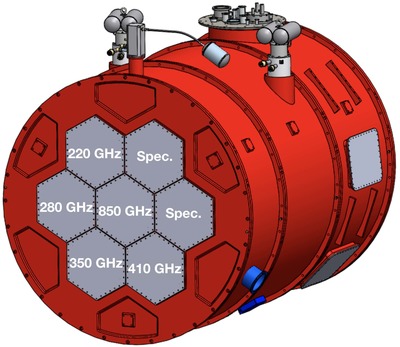CLASSE NEWS |
1 Oct 2019
Key piece of CCAT-prime sheds light on CLASSE research
Prime-Cam, the first-light instrument for
CCAT-prime, has been designed and is currently being developed for installation into the telescope. Prime-Cam will house seven instrument modules that can be individually optimized for particular science goals, and will serve as a critical component for the next-generation cosmic microwave background observatory.
The CCAT-prime telescope is being developed by an international team led by Cornell University. The first components such as Prime-Cam are currently being built. In 2021, the observatory will be fully constructed and reside at 18,400 feet above sea level, in the Atacama Desert of northern Chile.
Prime-Cam is the first-light instrument for the CCAT-prime telescope, which is located at a unique high and dry site in South America. It will take measurements that will inform us about our universe's composition, history, and evolution.
While CCAT-prime may not be buried
40' below ground, it is still an essential part of
CLASSE research as part of the laboratory's particle physics and astrophysics effort. The particle astrophysics group is engaged in sub-millimeter measurements and analysis of the cosmic microwave background as well as detector development at the cutting edge of superconducting and optical techniques, and it is these efforts that are pushing Prime-Cam to the forefront of cosmology and astrophysics.
Cornell is leading the CCAT telescope project consortium, and the team has decades of experience designing, building and deploying instrumentation for astronomical observations. With resources in nanofabrication, engineering, superconducting device design, testing and integration, and faculty, postdocs and students active in astrophysics, cosmology, instrumentation design and deployment, Cornell is an ideal institution to lead the CCAT-prime and Prime-Cam efforts.
CCAT-prime and Prime-Cam will rely on developments at the cutting edge of superconducting detector and optical techniques, which will advance the fields of cosmology and astrophysics, and contribute to the next generation of CMB telescopes and cameras so researchers can continue to untangle the mysteries still at large in particle physics and cosmology.
Sensitivity of the Prime-Cam Instrument on CCAT-prime. S.K. Choi et al
https://arxiv.org/abs/1908.10451
Prime-Cam consists of a 1.8 m diameter cryostat that can house seven individual instrument modules. Each instrument module, optimized for a specific science goal, will use state-of-the-art multichroic transition edge sensor (TES) or kinetic inductance detector (KID) arrays operated at ∼100 mK, and Fabry-Perot interferometers (FPI) for the EoR science.
Prime-Cam will be commissioned with staged deployments to populate the seven instrument modules. The full instrument will consist of 60,000 polarimetric KIDs at a combination of 220/280/350/410 GHz, 12,000 TES bolometers at 250/350 GHz coupled with FPIs, and 21,000 polarimetric KIDs at 850 GHz.
Prime-Cam is currently being developed, and the CCAT-prime telescope is designed and under construction by Vertex Antennentechnik GmbH to achieve first light in 2021. CCAT-prime is also a potential telescope platform for the future CMB Stage-IV observations.
Full publications:
"Prime-Cam: A first-light instrument for the CCAT-prime telescope"
(
https://arxiv.org/abs/1807.00058).
"The CCAT-Prime Submillimeter Observatory"
(
https://arxiv.org/pdf/1909.02587.pdf).

